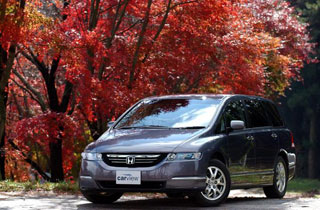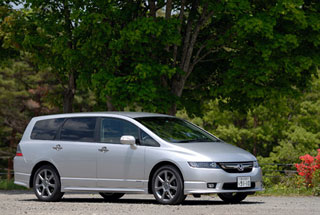Test drive Honda Odyssey 2004 - 2007
Comparison of the minivans Toyota Estima, Honda Odyssey, Mazda MPV
Who are they, possible competitors of the Toyota Estima car?A step forward in the right direction - so, probably, one can regard the fact of the appearance of a third -generation Toyota Estima on the market. If you count, it turns out that the last model of this family was born a little more than 15 years after the debut of the first car under the name. For any knowledgeable person, he only needs to look at the new car, it will not be difficult to understand that he was still in front of Estima, although a new model. But in fact, under this familiar, in general, appearance is hidden by a re-calculated supporting body and a completely updated power unit. We are interested in comparing this car with other popular minivans of a similar class.
So, at first, a few words about the Toyota Estima car, which is equipped with an engine with a working volume of 3.5 liters, the price of which ranges from 3 million 213 thousand to 3 million 885 thousand yen.
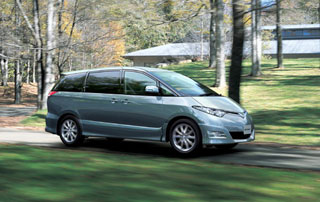 Extraced and perceived completely updated.
Extraced and perceived completely updated. From the very day when the first Toyota Estima car appeared on the market, a car that experts called only as promising or giving hope has passed more than 15 years. He really had a happy fate of the long -liver. It is enough to say that for 10 years, while its production was running, approximately 1 million 100 thousand cars were produced. Then the time has come to change generations. This happened, if anyone remembers, in 2000. After that, a 2-generation car was produced for 6 years, they were produced in a total of about 600 thousand units. And it should be recognized that when this model, along with the Honda Odyssey, attributes a decisive role in the formation of a new type of minivan in the Japanese market, this is by no means an exaggeration.
But on January 2006 came, and a new, third Estima model appeared on the market. Despite the catchy appearance, it is perceived as a car close in spirit to a previous car. This fact is a convincing evidence that the authors of the Estima project are deeply convinced: such a body configuration that can be dubbed as a monomer based on an ellipse and this is due to the peculiar appearance of Estima has far from exhausted their potential for the conquest of buyers' sympathy.
So with external forms everything seems to be clear. As for the internal content, there is a complete update here. Judge for yourself: the platform, the engine, and the design of the suspension - all these components were completely updated. It is unnecessary to say that new development is always additional expenses. And the fact that Toyota still decided to invest in this project, makes this model even more attractive for customers.
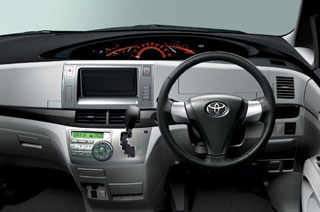 A distinctive feature of the Estima car of a new model is that this machine has never been equipped with an engine with such a large working volume. It should be reservated that this 3.5-liter engine with six V-shaped cylinders has already been tested by Lexus GS and IS brands, as well as in the Toyota Crown car. However, in preparation for installation on the minivan, he underwent alteration and refinement, in particular, with regard to the injection system. As a result of this, the developed power increased to 280 horsepower.
A distinctive feature of the Estima car of a new model is that this machine has never been equipped with an engine with such a large working volume. It should be reservated that this 3.5-liter engine with six V-shaped cylinders has already been tested by Lexus GS and IS brands, as well as in the Toyota Crown car. However, in preparation for installation on the minivan, he underwent alteration and refinement, in particular, with regard to the injection system. As a result of this, the developed power increased to 280 horsepower. What else is interesting to note is that this engine is combined with a 6-speed automatic gearbox. It is important, of course, not the fact of a combination of a powerful engine with a multi -stage automatic. The fact is that this time it was decided to abandon the AISHIN brand, which has already become traditional for Toyota cars, and instead use its own development, on which, according to the company representative, it was spent as many as 4 years. This metamorphosis has not become the only one. Another feature for the first time in a car going to the domestic Japanese market is the Bosh brake system. This, of course, is the business of the manufacturer, to decide which units to put on their own car, but the very fact of some changes in the selection of components cannot but intrigue.
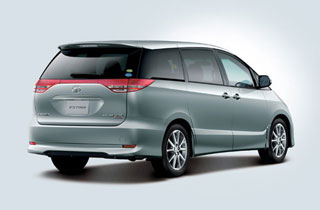 And one more interesting point: as one generation of Estima cars change, another, more and more importance is attached to its rating in the domestic Japanese market. Remember that the very first model was driven exclusively for the requirements of the North American buyer, but its descendant in the third knee is produced mainly for Japan. Why mainly, and not exclusively, because some of the cars will still go abroad - to the countries of the Asian region.
And one more interesting point: as one generation of Estima cars change, another, more and more importance is attached to its rating in the domestic Japanese market. Remember that the very first model was driven exclusively for the requirements of the North American buyer, but its descendant in the third knee is produced mainly for Japan. Why mainly, and not exclusively, because some of the cars will still go abroad - to the countries of the Asian region. Technical characteristics of the Estima 3.5ARARAS S model with a 7-seater body:
Length 4795 mm x width 1800 mm x height 1745 mm.
Wheel base: 2950 mm.
Machine weight: 1830 kg.
Drive: on the front wheels
Engine: 3.5-liter, 6-cylinder with V-shaped cylinders, developed power of 280 hp. at 6200 rpm, the largest torque 35.1 kg/m at 4700 rpm.
Machine price: 3 million 423 thousand yen.
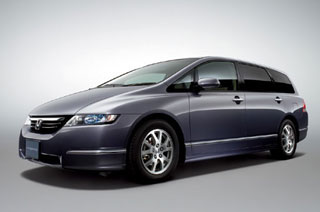 Competitor number 1 Honda Odyssey. Typical Honda with all the pros and cons.
Competitor number 1 Honda Odyssey. Typical Honda with all the pros and cons. According to external signs, in particular, at a low altitude, enough for the car to stand on the covered light parking, in the loop rear door - the Honda Odyssey car is not perceived as a direct competitor of the Estima car. But at the same time, the minivan positions won by this machine do not allow it to be discounted. Indeed, its layout, which is based on completely different principles than Toyota Estima, puts the Odyssey car on a par with passenger station wagons, which have an additional series of seats in the cabin. And according to some other signs, in particular, in the width of the review, opening from the driver's seat, or for the operation of the steering wheels suspension, this car resembles a sedan more than a minivan.
The Toyota Estima model is already produced in its third generation, but still claims to hold the title of the most stylish minivan. As for the Odyssey machine, after its creators felt that the competitors began to successfully reproduce its features and thus crowded it in the market, they resolutely began to look for a new horse. This skate was the height, more precisely, the lowland of her body. Thanks to targeted and consistent work on a decrease in the center of gravity and a decrease in the total height of the machine, the authors and developers of the Odyssey project
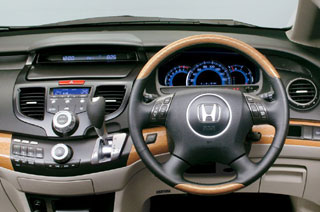 they achieved that, according to running indicators among cars with 3 rows of seats in the cabin, their brainchild seemed to be no equal. The matter came to the point that passengers sitting in both the 2nd and 3rd row have the same sensations when the car, for example, follows a section of the road abounding with steep turns. It is so unusual that they begin to get lost in conjecture: so what is it a minivan or not?! And this is the most accurately characterized the very essence of the modern Honda Odyssey car.
they achieved that, according to running indicators among cars with 3 rows of seats in the cabin, their brainchild seemed to be no equal. The matter came to the point that passengers sitting in both the 2nd and 3rd row have the same sensations when the car, for example, follows a section of the road abounding with steep turns. It is so unusual that they begin to get lost in conjecture: so what is it a minivan or not?! And this is the most accurately characterized the very essence of the modern Honda Odyssey car. Or take, for example, the appearance of the front panel of the cabin. Of course, in some places it sins excessive simplification, but with regard to the enlarged dashboard, its design is largely contrary to the generally accepted idea of \u200b\u200bhow this interior element should look in a typical Minivan family car. The control panel of the on -board navigation system, which at first causes a double attitude, is only worth starting to use it, is so thoughtful that it is quite possible to manage even blindly. The visual design of the navigation system (type Telematics), which is made in such a way that, God forbid, not once again distract the driver from the road, not at all as saturated as in the G-Book Alpha system, which is equipped with the Toyota Estima salon. But this does not prevent him from being no less interesting.
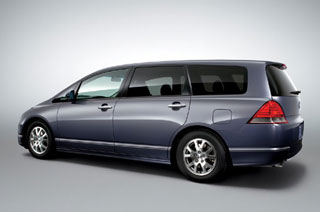 If you agree with the point of view that the Toyota Estima car, which is said to be aimed at the apple, is a bright representative of the car manufactured by Toyota, then the Odyssey car with its peculiar appearance is typical Honda.
If you agree with the point of view that the Toyota Estima car, which is said to be aimed at the apple, is a bright representative of the car manufactured by Toyota, then the Odyssey car with its peculiar appearance is typical Honda. Technical characteristics of the Honda Odyssey L:
Length 4765 mm x width 1800 mm x height 1550 mm.
Wheel base: 2830 mm.
Machine weight: 1650 kg.
Drive: on the front wheels
Engine: 2.4-liter, 4-cylinder with in-line cylinders, developed power of 160 hp. at 5500 rpm, the largest torque is 22.2 kg/m at 4500 rpm.
Machine price: 2 million 772 thousand yen.
Competitor number 2 Mazda MPV. An late excellent student who makes up missed.
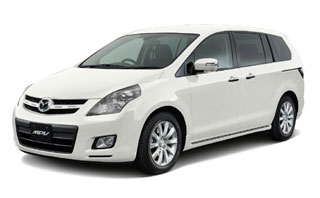 When developing this machine, someone announced the slogan that passengers who get places in the third row should still be located between the front and rear bridge. And for the sake of implementing this position, it was decided to lengthen 110 mm against the previous model, thus bringing this indicator to 2950 mm. But by a strange coincidence, it turned out that after a complete replacement of its model rows and the Mazda MPV car, and the Toyota Estima car was equal to this indicator.
When developing this machine, someone announced the slogan that passengers who get places in the third row should still be located between the front and rear bridge. And for the sake of implementing this position, it was decided to lengthen 110 mm against the previous model, thus bringing this indicator to 2950 mm. But by a strange coincidence, it turned out that after a complete replacement of its model rows and the Mazda MPV car, and the Toyota Estima car was equal to this indicator. There is another coincidence in the fate of these two cars: both of them began to be produced mainly for implementation within Japan, and not in the North America market, as it was before. And if so, then the body, according to the developers, if they can be relatively massive, still should not go out of the border reasonable by Japanese standards of the border in size. So it turned out that the length and width of the Mazda MPV car began to be 4860 mm respectively (for individual categories 4870 mm), and the width of 1850 mm. In other words, both in width and in length, the MPV model slightly went around the Estima car. Nevertheless, it is not strange, outwardly it is perceived even more compact than the Toyota machine. And the reason for this lies, as it seems to me, that the floor of the salon was slightly lowered down, respectively, the height of the car as a whole was also reduced. A decrease in the height of a new generation machine also takes place in the Toyota Estima model (40 mm), but this is still not as noticeable as the height of the height in the MPV car of a new model (45 mm).
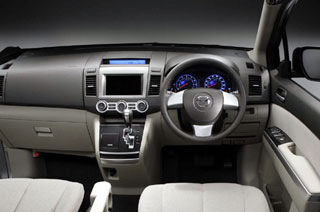 Either the designers of the Mazda company could not find a worthy 6-cylinder engine for a new MPV car, and the American motor, which is produced at a subsidiary, was not clear due to its noise and insufficient acceptance. But the fact remains: part of the MPV machines was decided to equip with 4-cylinder engines underly equipped with a turbocharger. To this end, a ready-made 2.3-liter engine was taken, which are equipped with Mazda Atenza cars and is reconfigured taking into account the features of the operation of minivan machines. In particular, its turbocharger (such as Turbo Charger) was reoriented so that the peak of the torque is shifted towards the speed range, which are most often used when driving at an average speed. As a result of such an improvement and the maximum power of the motor up to 245 hp, as well as thanks to the successful selection of a 6-speed automatic gearbox, the car began to be characterized by a wonderful acceleration dynamics. Oddly enough, it is in no way inferior to the similar indicator of the new Toyota Estima model, although, as already mentioned, the latter is equipped with a 6-cylinder V-shaped engine. True, it is only a little stronger than you need to press the accelerator pedal, as the feeling appears immediately that the turbocharger includes too actively. And this can cause an concern for those drivers who are accustomed to adhere to the regime of rigid fuel savings.
Either the designers of the Mazda company could not find a worthy 6-cylinder engine for a new MPV car, and the American motor, which is produced at a subsidiary, was not clear due to its noise and insufficient acceptance. But the fact remains: part of the MPV machines was decided to equip with 4-cylinder engines underly equipped with a turbocharger. To this end, a ready-made 2.3-liter engine was taken, which are equipped with Mazda Atenza cars and is reconfigured taking into account the features of the operation of minivan machines. In particular, its turbocharger (such as Turbo Charger) was reoriented so that the peak of the torque is shifted towards the speed range, which are most often used when driving at an average speed. As a result of such an improvement and the maximum power of the motor up to 245 hp, as well as thanks to the successful selection of a 6-speed automatic gearbox, the car began to be characterized by a wonderful acceleration dynamics. Oddly enough, it is in no way inferior to the similar indicator of the new Toyota Estima model, although, as already mentioned, the latter is equipped with a 6-cylinder V-shaped engine. True, it is only a little stronger than you need to press the accelerator pedal, as the feeling appears immediately that the turbocharger includes too actively. And this can cause an concern for those drivers who are accustomed to adhere to the regime of rigid fuel savings. 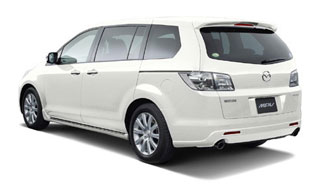 It should be noted that the MPV model with a simple engine also develops a decent traction, and the suspension of controlled wheels is made in such a way that the balance between controllability and comfort is at a fairly high level. Thanks to this, the machine, although not turbo, demonstrates decent running qualities. Although in fairness it should be replaced, which, probably due to the rough quality of the materials used to finish the car, it does not look as pretentious as Toyota Estima or Honda Odyssey. Well, let him come later, and looks a little more modest. The more he has a diligent student.
It should be noted that the MPV model with a simple engine also develops a decent traction, and the suspension of controlled wheels is made in such a way that the balance between controllability and comfort is at a fairly high level. Thanks to this, the machine, although not turbo, demonstrates decent running qualities. Although in fairness it should be replaced, which, probably due to the rough quality of the materials used to finish the car, it does not look as pretentious as Toyota Estima or Honda Odyssey. Well, let him come later, and looks a little more modest. The more he has a diligent student. Technical characteristics of the Mazda MPV 23C Sporty Package model:
Length 4870 mm x width 1850 mm x height 1685 mm.
Wheel base: 2950 mm.
Machine weight: 1730 kg.
Drive: on the front wheels
Engine: 2.3-liter, 4-cylinder with in-line cylinders, developed power 163 hp. at 6500 rpm, the largest torque is 21.4 kg/m at 4000 rpm.
Machine price: 2 million 596 thousand yen.
Source: Webcg.net








